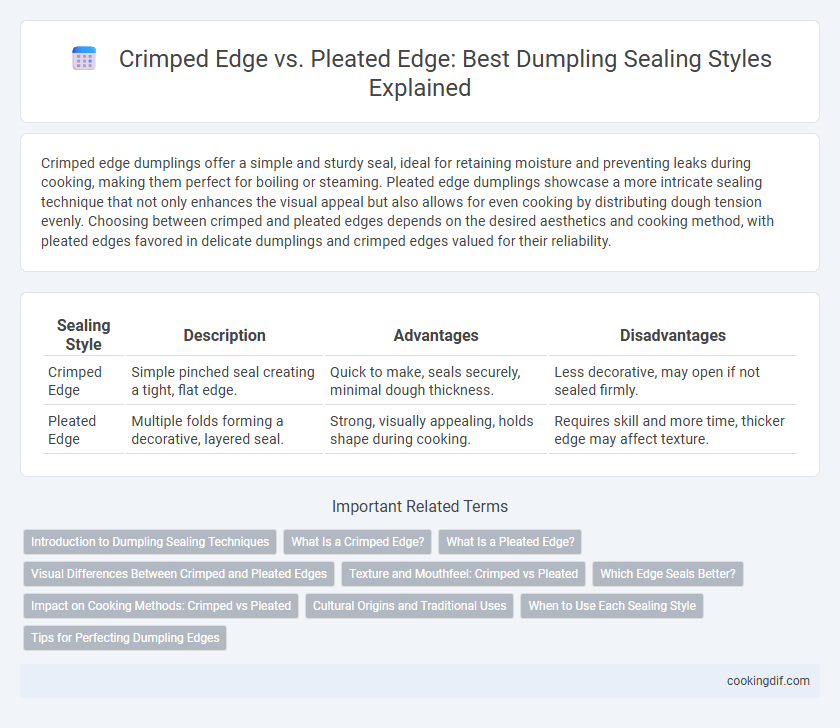Crimped edge dumplings offer a simple and sturdy seal, ideal for retaining moisture and preventing leaks during cooking, making them perfect for boiling or steaming. Pleated edge dumplings showcase a more intricate sealing technique that not only enhances the visual appeal but also allows for even cooking by distributing dough tension evenly. Choosing between crimped and pleated edges depends on the desired aesthetics and cooking method, with pleated edges favored in delicate dumplings and crimped edges valued for their reliability.
Table of Comparison
| Sealing Style | Description | Advantages | Disadvantages |
|---|---|---|---|
| Crimped Edge | Simple pinched seal creating a tight, flat edge. | Quick to make, seals securely, minimal dough thickness. | Less decorative, may open if not sealed firmly. |
| Pleated Edge | Multiple folds forming a decorative, layered seal. | Strong, visually appealing, holds shape during cooking. | Requires skill and more time, thicker edge may affect texture. |
Introduction to Dumpling Sealing Techniques
Crimped edge and pleated edge are two popular dumpling sealing techniques that ensure a secure hold while adding distinctive textures to the dumpling's appearance. The crimped edge involves pinching the dough firmly along the seam, creating a simple, durable seal ideal for boiled or steamed dumplings. The pleated edge, characterized by a series of folded pleats along the rim, offers an elegant look and helps trap more juices inside, commonly used in pan-fried or steamed varieties.
What Is a Crimped Edge?
A crimped edge in dumpling sealing is created by pinching the dough together along the seam, forming a simple and secure closure. This technique ensures the filling stays intact during cooking by tightly pressing the edges without extra folds. Crimped edges offer a straightforward, efficient seal that complements both rustic and refined dumpling styles.
What Is a Pleated Edge?
A pleated edge on a dumpling involves folding the dough in small, overlapping pleats to securely seal the filling, creating a decorative and textured appearance. This technique enhances the dumpling's structural integrity, preventing leaks during cooking and adding visual appeal to dishes such as Chinese jiaozi and Japanese gyoza. The pleated edge contrasts with crimped edges, which use simple pinching for sealing, offering a more intricate finish and improved grip on the dough.
Visual Differences Between Crimped and Pleated Edges
Crimped edges on dumplings showcase a simple, uniform zigzag pattern created by pressing the dough together, forming a tight seal with a clean, consistent look. Pleated edges display a series of intricate folds or pleats that create a scalloped appearance, offering a more decorative and textured finish. The visual distinction lies in crimped edges being smooth and geometric, while pleated edges appear layered and sculpted, enhancing the dumpling's aesthetic appeal.
Texture and Mouthfeel: Crimped vs Pleated
Crimped edges create a tight, uniform seal that results in a firmer texture and a slightly chewy mouthfeel, enhancing the dumpling's structural integrity during cooking. Pleated edges offer a delicate, layered texture that produces a softer bite and adds a subtle complexity to the dumpling's overall mouthfeel. The choice between crimped and pleated edges significantly influences the tactile experience, with crimped edges emphasizing durability and pleated edges highlighting tenderness.
Which Edge Seals Better?
Crimped edges create a tighter seal by pressing the dough firmly together, reducing the risk of filling leakage during cooking. Pleated edges, while decorative, may have small gaps between folds, making them less effective at preventing spills. For optimal sealing performance, crimped edges are generally preferred over pleated edges in dumpling preparation.
Impact on Cooking Methods: Crimped vs Pleated
Crimped edges create a tighter seal, making dumplings better suited for boiling and steaming by preventing filling leakage and retaining moisture. Pleated edges enhance texture and appearance, ideal for pan-frying as they provide multiple layers that crisp up nicely without compromising structural integrity. Choosing between crimped and pleated edges affects cooking outcomes by influencing how well the dumpling holds together under different heat applications.
Cultural Origins and Traditional Uses
Crimped edges are commonly associated with Eastern European dumplings like pierogi, where a simple, firm seal preserves fillings such as potatoes and cheese, reflecting rustic culinary traditions. Pleated edges dominate in East Asian dumplings like Chinese jiaozi, showcasing intricate folding techniques that symbolize craftsmanship and are designed to hold juicy fillings securely during boiling or steaming. Each sealing style embodies cultural heritage and practical needs, with crimping emphasizing durability and pleating highlighting aesthetic elegance and cooking method compatibility.
When to Use Each Sealing Style
Crimped edge sealing is ideal for thicker dumpling doughs or fillings with higher moisture content to ensure a strong, leak-proof seal during boiling or steaming. Pleated edge sealing is best suited for thinner doughs and fillings where a decorative, traditional appearance is desired, especially for pan-fried or steamed dumplings. Choosing the sealing style depends on the cooking method and dough texture to maintain dumpling integrity and enhance presentation.
Tips for Perfecting Dumpling Edges
Crimped edges create a tight seal by pressing the dough firmly along the dumpling's perimeter, preventing leakage during cooking and ensuring structural integrity. Pleated edges involve folding the dough into small, decorative pleats that not only enhance visual appeal but also reinforce the seal by layering the dough multiple times. To perfect dumpling edges, maintain consistent dough thickness, moisten the edges lightly with water for better adhesion, and practice uniform pressure when sealing to avoid gaps and uneven cooking.
Crimped edge vs Pleated edge for dumpling sealing styles Infographic

 cookingdif.com
cookingdif.com